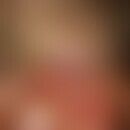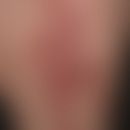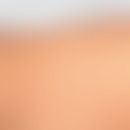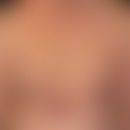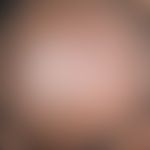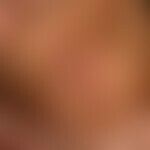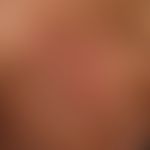Synonym(s)
DefinitionThis section has been translated automatically.
Tinea capitis is an infectious fungal disease of the terminal hair, eyebrows and eyelashes caused by pathogens of the genera Trichophyton and Mikrosporum.
PathogenThis section has been translated automatically.
-
Dermatophytes:
- frequently Microsporum canis (> 50%)
- rarer
- Trichophyton tonsurans
- Trichophyton mentagrophytes (about 15-25%)
- Trichophyton verrucosum (10-22%)
- Trichophyton rubrum (about 10-15%)
- Trichophyton violaceum
- Trichophyton soudanese
- Trichophyton schoenleinii
- M. audouinii
- Trichophyton (Arthroderma) benhamiae (perfect form of Trichophyton mentagrophytes).
You might also be interested in
ClassificationThis section has been translated automatically.
From a clinical point of view, a distinction is made between 2 forms whose development is pathogen-dependent:
-
Superficial or aphlegmatic form (Grey-patch tinea); mostly anthropophilic pathogens, see below Tinea capitis superficialis
- moth-eaten tinea capitis
- "Black-dot" form of tinea capitis. Slightly inflammatory form, hairs broken off at the skin level like stubble (tinea capitis superficialis)
- Pityriasis - capillitii-like tinea capitis. Prominent diffuse scaling of the scalp without signs of inflammation
- Pustulous tinea capitis with yellowish follicular pustules.
- Deep, phlegmatic (chronic inflammatory infiltrative) form, see below Tinea capitis profunda; see also Kerion Celsi (always zoophilic pathogens);
For historical reasons, in addition to the infection criterion (superficial or deep tinea), tinea capitis is often divided into:
- microsphere
- and (the special case)
- Favus
ManifestationThis section has been translated automatically.
Almost exclusively in children aged 2-14 years. Tinea capitis is a distinct rarity in adults.
ClinicThis section has been translated automatically.
The clinical picture is varied (see classification). Depending on the pathogen and the immune situation of the diseased person, it includes a simple non-inflammatory, a seborrhoeic dermatitis-like disease (often caused by T.tonsurans). Furthermore, grey-scaly alopecic areas or, in the inflammatory forms, granulomatous plaques or nodules are found, often interspersed with follicular pustules.
DiagnosisThis section has been translated automatically.
According to the guidelines, the following guidelines apply for pathogen detection:
- Pathogen detection before therapy
- Therapy always systemic+adjuvant topical
- Objective: negative culture
- Zoophilic pathogen: Testing pets
- Anthrophilous pathogen: examine contact persons.
Microscopic examination of depilated hair and dandruff. Anthrophilic pathogens mainly grow endotrich (penetrating into the hair).
The exception is M. audouinii (see below microsphere).
Zoophilic pathogens grow ectotrich (around the hair) with large spore cuffs. Therefore, zoophilic pathogens are highly contagious.
Cultures must be observed for up to 5 weeks, because some pathogens ( T. verrucosum, T. violaceum, T. soudanense) grow very slowly.
Differential diagnosisThis section has been translated automatically.
TherapyThis section has been translated automatically.
General therapyThis section has been translated automatically.
Basically, the necessity arises to always treat the tinea capitis combined systemically and locally. The pathogen specification is important as some antimycotics are less sensitive towards certain pathogens. In the European Society for Pediatric Dermatology guideline, the antifungal agents terbinafine, itraconazole, fluconazole (regardless of their approval status) were given recommendation grade A.
- For Trichophyton species, terbinafine is the agent of choice due to its high efficacy and lack of pathogen gaps.
- Itraconazole and griseofulvin have reduced efficacy.
- Fluconazole is resistant to Trichophyton mentagrophytes var. granulosum and Trichophyton verrucosum.
Adults:terbinafine, griseofulvin (off label in Germany), itraconazole, fluconazole. Children:
- Only griseofulvin is approved for systemic therapy, fluconazole for children > 1 year. Itraconazole or terbinafine can only be prescribed as an individual therapeutic trial ( off-label use), after appropriate information of the parents.
- Itraconazole should only be prescribed for a maximum of 3 months due to potential toxic effects.
In a randomized comparative study of all commercially available antifungal agents, 50 children each with tinea capitis caused by a Trichophyton species were treated as follows: Griseofulvin (20mg/kgKG/day for 6 weeks), Terbinafine (>40kg bw - 250mg/day, 20-40kg bw - 125mg/day for 2 or 3 weeks), Itraconazole (5mg/kgKG/day 2 or 3 weeks), Fluconazole (6mg/kgKG/day 2 or 3 weeks). The cure rates after 12 weeks were: griseofulvin 92%, terbinafine 94%, itraconazole 82%, fluconazole 82%.
External therapyThis section has been translated automatically.
Local treatment with a topical antifungal agent of the fungicidal action type (cicloproxolamine, terbinafine) is recommended. This should be applied to the entire capillitium. Supplementary antimycotic shampoos should be used 2x a week.
In highly inflammatory forms, the use of fixed combinations of glucocorticoids and antifungals is recommended initially (maximum duration 1-2 weeks) (Mayser P 2014). Glucocorticoids lead to rapid decongestion of acute weeping lesions with resolution of pain and itching.
Internal therapyThis section has been translated automatically.
Overview of systemic therapeutics for the treatment of tinea capitis | ||
Active substance |
Dosage |
Duration of therapy |
| Griseofulvin (Griseo CT 125) in Germany off the market | 10 mg/kg bw/day (internationally 20 mg/kg bw/day recommended) 1 time/day as ED after meals | 8 weeks, if necessary also considerably longer (up to 1 year), adapted to the clinical picture |
| Itraconazole¹ (Sempera) | 5 mg/kg bw/day (1 time/day together with food) | 6-8 weeks (see above) |
| Terbinafine¹ (Lamisil) | < 20 kg bw: 62.5 mg/day | 6-8 weeks (see above) |
| 20-40 kg bw: 125 mg/day | ||
| > 40 kg bw: 250 mg/day | ||
| Fluconazole² (Diflucan) | 6 mg/kg bw/day or 1 time/week 8 mg/kg bw/day | 6-8 weeks (see above) |
| ¹ Preparations not approved for children; ² Approved for children > 1 year of age in the absence of alternatives Comment: Despite the approval of griseofulvin in children and the efficacy of itraconazole, both preparations are hardly ever used because of side effects (griseofulvin) and poor absorption (itraconazole). The drug of choice for Trichophyton species is Terbinafine. All Microsporum species are sensitive to fluconazole. | ||
Note(s)This section has been translated automatically.
The term "tinea" (Latin for woodworm or moth) is the historically developed term for a dermatophyte infection of the hairy head, which was compared to a "moth-eaten" picture.
Itraconazole has not yet been approved for use in children. However, studies have shown good therapeutic success. In a randomized study with 34 children (< 12 years), tinea capitis was treated with 500 mg griseofulvin and 100 mg itraconazole daily for a total of 6 weeks. Both groups showed an identical treatment success with 88% cure. In addition, no side effects occurred in the group treated with itraconazole.
LiteratureThis section has been translated automatically.
- Elewski BE et al (2000) Tinea capitis: a current perspective. J Am Acad Dermatol 42: 1-20
- Fuller LC et al (2003) Scalp ringworm in south-east London and an analysis of a cohort of patients from a paediatric dermatology department. Br J Dermatol 148: 985-988
- Fuller LC et al (2003) Diagnosis and management of scalp ringworm. BMJ 326: 539-541
- Ginter-Hanselmayer et al.(2011) The treatment of Tineda capitis - a critical review. JDDG9: 109-115
- Gray RM et al (2015) Management of a Trichophyton tonsurans outbreak in a day-care center. Pediatric Dermatol 32:91-96.
- Hay RJ et al (2001) Mycology Working Party on Tinea Capitis. Tinea capitis in Europe: new perspective on an old problem. J Eur Acad Dermatol Venereol 15: 229-233
- Higgins EM (2000) Guidelines for the management of tinea capitis. British Association of Dermatologists. Br J Dermatol 143: 53-58
- Kolivras A et al (2003) Tinea capitis in Brussels: Epidemiology and New Management Strategy. Dermatology 206: 384-387
- Mayser P (2014) Importance of glucocorticosteroids in the therapy of Kerion Celsi. skin 2014: 172-176
- Carrot M et al (2002) Tinea capitis. Therapeutic options in the post-griseofulvin era. dermatologist 53: 788-794
- Nenoff P et al (2014) Mycology - An Update Part 2: Dermatomycoses: Clinical picture and diagnostics. YYG 12: 749-778
- Rippon JW et al (1993) Cutaneous antifugal agents. Dekker, New York Basel Hong Kong, S. 199-214
- Seebacher C, Abeck D (2003) tinea capitis-current pathogen spectrum, mycological diagnostics and therapy. Dt Ärztebl 100: 2385-2389
- Seebacher C et al (2006) Tinea capitis. J Dtsch Dermatol Ges 4: 1085-1091
- Seebacher C et al (2007) Tinea of the free skin. J Dtsch Dermatol Ges 11: 921-926
Incoming links (14)
Dermatomycoses; Eosinophilic pustular folliculitis; Itraconazole; Microsphere; Microsporum audouinii; Pediculosis capitis; Psoriasis capitis; Superficial tinea capitis; Terbinafine; Tinea capitis profunda; ... Show allOutgoing links (24)
Benhamiae trichophyton; Dermatophytes; Endotrich; Favus; Fluconazole; Glucocorticosteroids; Griseofulvin; Itraconazole; Kerion celsi; Level of evidence; ... Show allDisclaimer
Please ask your physician for a reliable diagnosis. This website is only meant as a reference.
